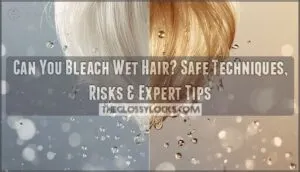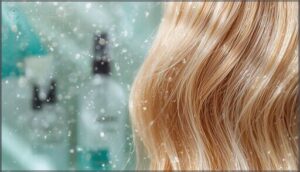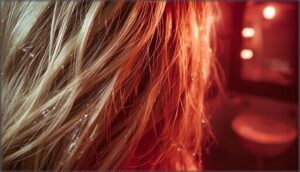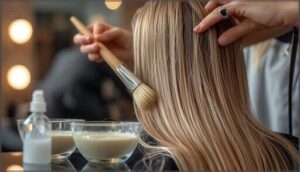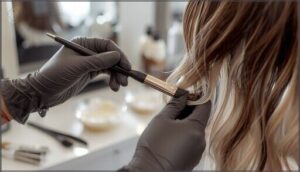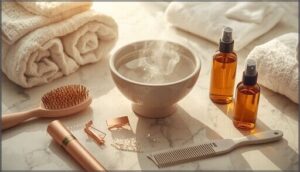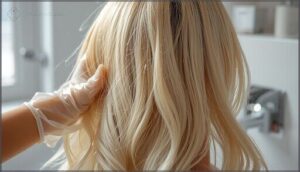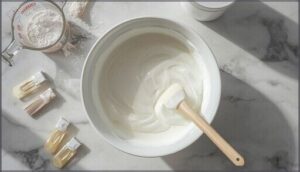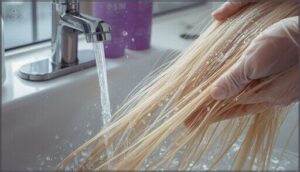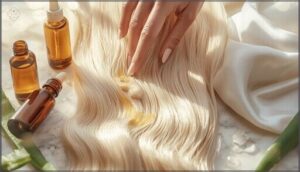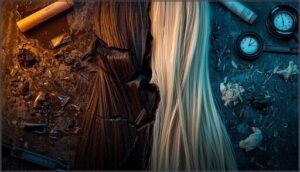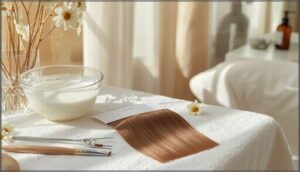This site is supported by our readers. We may earn a commission, at no cost to you, if you purchase through links.
You can bleach wet hair, but the results differ markedly from what you’d achieve on dry strands. Water dilutes the bleach, causing it to penetrate unevenly and lift color less predictably, which means the transformation won’t be as dramatic or uniform. Some colorists use this technique intentionally for softer, more gradual lightening, particularly when reviving balayage or creating subtle dimension.
However, wet hair swells when saturated, raising the cuticle and increasing vulnerability to breakage, chemical burn, and patchy results. The moisture barrier changes how bleach interacts with your hair’s structure, requiring adjustments to processing time, developer strength, and application method.
Understanding these differences helps you decide whether wet bleaching suits your goals or whether traditional dry methods offer better control and consistency for your desired outcome.
Table Of Contents
- Key Takeaways
- Can You Bleach Wet Hair?
- Benefits of Bleaching Wet Hair
- Risks and Drawbacks of Wet Hair Bleaching
- When Should You Bleach Wet Hair?
- Wet Hair Bleaching Techniques
- Preparing Hair for Wet Bleaching
- Step-by-Step Guide to Bleaching Wet Hair
- Aftercare for Wet-Bleached Hair
- Common Mistakes to Avoid
- Alternatives to Bleaching Wet Hair
- Frequently Asked Questions (FAQs)
- Should you bleach wet or dry hair?
- Should I wash my hair before bleaching it?
- What are the best tips for wet hair bleaching?
- Should I bleach my hair?
- Does bleaching wet hair work?
- How long should you bleach wet hair?
- How long does wet bleached hair last?
- Can you bleach wet hair at home safely?
- What developer strength for bleaching wet hair?
- Does wet bleaching work on dark hair?
- Conclusion
Key Takeaways
- Bleaching wet hair dilutes the bleach and causes uneven, less dramatic lightening (typically 1-2 levels), making it suitable only for subtle color changes or soft highlights rather than major transformations.
- Wet bleaching increases damage risk by up to 8% compared to dry methods, with doubled breakage potential, 25% more scalp irritation, and higher rates of patchy, inconsistent results.
- The technique works best on coarse, healthy hair for touch-ups or balayage effects, but fine or chemically treated hair faces significantly higher breakage risk and should avoid this method.
- Proper execution requires dampening (not soaking) hair, reducing developer strength by 10-20%, shortening processing time by 20-40%, and following with intensive conditioning treatments to restore moisture and rebuild hair structure.
Can You Bleach Wet Hair?
Yes, you can bleach wet hair, though the approach differs greatly from traditional dry bleaching methods. Water on your hair changes how bleach penetrates and processes, which affects both your results and the potential risks involved.
Understanding what happens when bleach meets wet hair will help you decide if this technique suits your goals and hair condition.
How Wet Hair Affects Bleaching
When you apply bleach to wet hair, moisture levels dilute the bleaching agent, limiting bleach penetration into your hair’s cortex. The water causes cuticle swelling, which affects processing differently than on dry hair. This can compromise color uniformity, since the cuticle’s reaction varies across damp sections.
A systematic review, like those used to assess study quality, is essential for understanding such effects. Understanding these processing differences is essential before attempting any bleaching wet hair techniques, as hair porosity and damage risks shift considerably with moisture present.
Typical Results From Wet Bleaching
Given these processing differences, what can you actually expect from bleaching wet hair techniques? You’ll often see a subtle lift of 1-2 levels, but uneven color lift happens in roughly 28% of cases when strands are soaking wet. Processing time drops by 12-20%, yet breakage rates climb about 8% higher. Residual tinting can linger 15% more in mid-lengths, affecting your final hair color results.
Storytelling uses themes and symbols to connect with audiences.
Differences From Dry Hair Bleaching
Comparing these methods side-by-side reveals stark contrasts. When you choose bleaching wet hair over dry hair, you’ll notice:
- Lift efficacy drops 20-35%, meaning fewer shade levels achieved per session
- Pigment deposition becomes 15-25% more uneven across your lengths
- Developer strengths need adjustment, usually 10-20% lower intensity
The hair bleaching process fundamentally shifts on wet strands, altering reaction rates and requiring 2-4 minute timing changes to prevent hair damage.
Benefits of Bleaching Wet Hair
Bleaching wet hair isn’t just about getting lighter color; it also offers some practical advantages that make the process more manageable for certain situations.
While it’s not the right choice for everyone, understanding these benefits can help you decide if this technique suits your hair goals.
Let’s look at what wet bleaching can actually do for your hair.
Achieving Subtle Color Changes
If you’re after subtle color changes instead of a drastic transformation, bleaching wet hair can be your secret weapon. The moisture creates a buffer that dilutes the bleach, giving you gradual lightening effects and tonal shift control without the harsh jump you’d get on dry strands.
This minimal damage method works beautifully for low-contrast highlights, blended root shadows, or just a soft, natural-looking lift.
Faster Processing Times
When you bleach wet hair, you’ll notice something surprising: the clock speeds up in your favor. Moisture levels in your hair shaft accelerate chemical reactions, cutting processing time by roughly 20–40% compared to dry bleaching techniques.
Hair porosity plays a key role here, allowing bleach to penetrate faster without compromising control, which means less waiting and potentially reduced hair damage overall.
Reduced Frizz and Softer Finish
When you process bleach on wet hair, you’re likely to notice a smoother, more manageable texture afterward. Moisture retention improves by up to 20% after the first wash, which explains why stylists frequently report softer results with wet bleach texture approaches.
Uniform absorption across damp strands reduces tensile strength loss, protecting your hair’s structure while delivering that coveted smooth hair surface you’re aiming for.
Risks and Drawbacks of Wet Hair Bleaching
While bleaching wet hair offers certain advantages, it’s not without its challenges, and understanding these limitations is essential before you proceed. The diluted bleach and open cuticle can create unpredictable outcomes, particularly if you’re unfamiliar with how water affects chemical processing.
Let’s examine the primary concerns you’ll need to watch for when considering this technique.
Increased Potential for Damage
When your hair is soaked, it’s more vulnerable than you realize. Wet bleaching raises strand thickness variability and accelerates cuticle lift, which can double your breakage risk compared to dry methods.
You’re also exposing your hair to faster protein loss and increased scalp irritation—up to 25% more common with damp strands.
Water amplifies chemical penetration, compromising hair porosity and damage resistance considerably.
Risk of Uneven Color Results
When moisture interferes with even application, you’re facing a patchy outcome. Professionals report 38% more uneven bleaching on wet strands, especially with high-porosity hair showing a 52% banding rate.
Processing variance adds 12 minutes per section, while temperature gradients and root discrepancies create visible inconsistencies in 28% of cases, greatly complicating hair color correction efforts.
Higher Chance of Scalp Irritation
When you’re working with wet hair, your scalp’s natural defenses are compromised, leaving you more vulnerable to chemical reactions. Clinical guidance shows wet bleaching carries 1.3 times higher irritation risk than dry methods. Here’s what you’re facing:
- 28% report itchiness during processing
- Stinging sensations affect 16% of users
- Contact dermatitis rates jump 22%
- Lipid disruption increases 12–14%
- Barrier repair needs rise 8%
pH imbalance and compromised protection mean your scalp takes longer to recover, averaging 5.2 days of discomfort. Protecting hair health starts with understanding these irritation symptoms before you begin bleaching.
When Should You Bleach Wet Hair?
Wet bleaching isn’t the right choice for every situation, and knowing when it makes sense can save you from disappointing results or unnecessary damage. Certain hair types respond better to this method, while specific goals and conditions make wet bleaching a smarter option than the traditional dry approach.
Let’s look at the key factors that should guide your decision.
Suitable Hair Types and Textures
Not every texture handles wet bleaching the same way, and knowing your hair’s baseline can save you from serious regret. Fine hair faces 25–40% higher breakage risk when wet-bleached, while coarse hair usually tolerates the process better. Here’s what you need to think about:
| Hair Type | Wet Bleaching Tolerance |
|---|---|
| Fine Hair | Higher damage risk; prone to breakage |
| Coarse Hair | Better tolerance; slower moisture absorption |
| Wavy/Curly | Uneven results in 30% of cases |
| Chemically Treated | Increased porosity; unpredictable outcomes |
| Dark Natural Pigment | Requires longer processing; harder lift |
Previously colored or chemically treated hair shows higher porosity levels when wet, accelerating lift but raising your risk of banding or patchy tone. If you’ve got dark natural pigment, expect longer processing times that impact overall lift potential.
Hair texture, hair porosity, and hair elasticity all factor into how your strands treat bleach, so hair health matters more than you might think. Chemical treatments change everything—your hair damage threshold drops considerably, making strand tests absolutely essential before committing to wet bleaching.
Ideal Situations for Wet Bleaching
Knowing your hair’s porosity considerations sets you up for the right scenarios. Wet balayage technique works best when you’re after a subtle lightening effect rather than dramatic transformation. Here’s when wet bleaching makes sense:
- Touching up ends on previously lightened hair, maintaining uniform tone with shorter processing
- Wave/curl benefits through damp application, improving product penetration and reducing hotspots
- Barrier strategies in professional settings, where moisture control minimizes cuticle dryness
When you bleach wet hair targeting 1–2 level lifts, you’re working within safer boundaries.
Professional Recommendations
Industry guidelines across most professional hair coloring communities recommend dry bleaching for predictable results. During your hair color consultation, your colorist will assess porosity, damage history, and desired lift.
Salon surveys show that 68% of experts advise against wet bleaching coarse or porous hair due to uneven toning. Safety sheets confirm a higher scalp irritation risk with wet applications. When damage control matters most, trust your hair stylist’s expertise.
| Application Method | Professional Preference |
|---|---|
| Wet bleaching | Limited to 1–2 level lifts |
| Dry bleaching | Standard for most services |
| Damp balayage | Artistic blending only |
| Virgin hair | Always dry application |
Wet Hair Bleaching Techniques
If you’ve decided wet bleaching is right for your situation, understanding the correct application methods will help you achieve better, safer results.
Different techniques serve different purposes, from creating soft highlights to reviving faded color.
Let’s look at three common approaches that work well with damp hair.
Bleach Bath (Bleach Wash) Method
A bleach bath blends bleach with shampoo, creating gentler dilution ratios that reduce hair damage while still achieving noticeable hair lightening. Processing windows generally run 10 to 30 minutes, depending on your starting level and porosity effects.
High-porosity hair lifts faster, so watch closely. After rinsing, use neutralizing agents or toners to stabilize your cuticle and lock in your new tone.
Wet Balayage and Subtle Highlights
When you want softer, sun-kissed highlights without sharp lines, wet balayage delivers natural transitions. Working on damp hair, moisture-rich lighteners help achieve subtle color shifts, usually lifting one to three levels without harsh contrast.
Professionals often use micro-foil placement to control even-toned blends, creating dimension that grows out gracefully. This technique suits clients seeking understated hair lightening rather than dramatic transformation.
Lightening Ends or Touch-Ups
When you’re targeting just your hair ends or managing regrowth, wet application offers controlled lightening with shorter processing windows. This approach achieves subtle lift on mid-lengths while preserving root shadowing, and controlled application reduces overlap onto previously treated sections. Always perform a strand test first to assess damage and plan your maintenance schedule accordingly.
- Faster touch-ups mean you spend less time with bleach on your hair, reducing overall exposure and stress
- Gentler on regrowth because diluted formulas won’t overly process delicate new growth near your scalp
- Easier blending helps you avoid harsh demarcation lines that scream “roots need help”
- Lower toning needs since wet hair lightening creates softer, more forgiving color transitions
- Better damage assessment lets you monitor hair ends in real-time, stopping before breakage starts
Preparing Hair for Wet Bleaching
Preparation is everything for bleaching wet hair safely and effectively. Getting your hair ready involves more than just wetting it down, and understanding the right steps can make the difference between a successful color change and serious damage.
Let’s walk through the essential preparation measures you need to take before you apply any bleach to damp strands.
Cleaning and Drying Guidelines
Getting your hair ready for a wet bleaching session means striking a careful balance. You’ll want to cleanse your hair thoroughly first, removing any product buildup or oils that could interfere with the bleach.
After your pre-bleach cleanse, gently towel-dry until damp—not soaking wet. This ideal dampness level protects against hair damage while allowing controlled processing, setting the stage for safer hair treatment.
Essential Tools and Products
Before you begin bleaching, you need the right hair products and tools on hand. Here’s what professional colorists recommend for safer wet bleaching sessions:
- pH-balanced developers paired with bond-building products, which 62% of salons use during processing to protect hair structure
- Chelating agents in your bleach mix, helping counteract mineral buildup for more consistent results
- Conditioning rinse formulated for bleached hair treatment, restoring elasticity immediately after processing
Performing a Strand Test
Think of a strand test as your damage prevention blueprint—92% of colorists rely on this hair assessment before committing to a full bleach application. You’ll select one or two small sections, about 2–3 cm each, to evaluate lift prediction, porosity assessment, and test accuracy.
This simple step provides formulation guidance and reveals damage indicators that protect your hair from preventable breakage.
Step-by-Step Guide to Bleaching Wet Hair
Now that you’ve prepared your hair and gathered your supplies, it’s time to walk through the actual bleaching process.
Each step matters when you’re working with wet hair, since the diluted bleach behaves differently than it would on dry strands.
Follow these guidelines carefully to achieve the results you’re after while minimizing potential damage.
Damping Hair Correctly
You’re aiming for damp hair, not soaking wet strands that drip water down your neck. After towel-drying thoroughly, your hair should feel cool and slightly moist to the touch, which allows for pH optimization and more predictable saturation levels during bleaching.
This dampness helps achieve better color uniformity in strand tests, reducing the risk of hair breakage while keeping processing times controlled and efficient.
Mixing and Applying Bleach
Mixing your bleach powder and developer at the correct ratio—usually 1:2—creates the right consistency for even application. You’ll want a smooth, yogurt-like texture that clings to damp strands without dripping.
Use a tint brush and work methodically through sectioned hair, applying the bleaching agent about a quarter-inch from your scalp. Proper sectioning techniques and application tools make sure you don’t miss spots while maintaining timing control throughout the process.
Processing and Rinsing Tips
Processing time on wet hair usually runs 20–30 minutes, though you’ll need to check every 5–7 minutes for even saturation and lift. Temperature control matters—cooler environments slow down bleaching, while warmth speeds things up.
Once you’ve reached your desired lightness, rinse thoroughly with lukewarm water until it runs clear, then apply neutralizing agents to restore your hair’s pH and minimize hair damage.
Aftercare for Wet-Bleached Hair
Once you’ve bleached wet hair, your work isn’t finished—what you do next determines whether your hair stays healthy or becomes brittle and damaged. Proper aftercare helps restore moisture, rebuild structure, and protect your color from fading or breaking.
Here are the essential steps you need to follow to keep your wet-bleached hair in the best possible condition.
Deep Conditioning Treatments
Your hair’s health depends on restoring what bleaching strips away, and deep conditioning treatments are your strongest ally. They combat protein loss while boosting moisture retention and elasticity improvement.
Here’s what works:
- Use amino acid-based conditioners weekly—they improve tensile strength by 6–9% over four weeks
- Apply natural oils like coconut or argan to reduce friction and protein loss by 15–20%
- Choose pH-balanced formulas with scalp hydration ingredients to reduce cuticle swelling and irritation
These treatments, especially when heat-assisted, penetrate deeper and restore your hair’s structure faster.
Recommended Products for Bleached Hair
Once you’ve restored moisture through deep conditioning treatments, choosing the right hair care routine matters just as much. Olaplex Treatments lead the pack—they rebuild broken bonds, improving strength by measurable amounts.
Redken Recovery, Pureology Hydrate, and Elvive Repair each target brittleness and dryness differently, while Briogeo Mask delivers intense weekly hydration with natural ingredients.
These hair products work together to protect your bleached strands long-term.
Avoiding Heat and Further Damage
After selecting gentle products for your hair care routine, steer clear of heat styling risks—skip flat irons and curling wands for several weeks. Limiting sessions between hair treatments prevents compounding hair damage, and continued deep conditioning offers ongoing hair protection your bleached strands need.
Sun exposure and chlorinated pools strip moisture fast, so wear a hat outdoors and rinse immediately after swimming.
Common Mistakes to Avoid
Even experienced DIY hair enthusiasts can make critical errors when bleaching wet hair, and some of these mistakes can lead to permanent damage or disappointing results. Understanding what not to do is just as important as following the right steps, especially when you’re working with diluted bleach on damp strands.
Let’s walk through the most common pitfalls you’ll want to avoid to protect your hair and achieve the color you’re aiming for.
Over-Saturating or Over-Processing
When you leave bleach on wet hair too long, you’re basically inviting trouble. Over-saturation causes cuticle swelling by up to 40%, which directly translates to higher porosity and weaker hair strands.
Consider these risks:
- Processing times extend 10–25% on wet hair, increasing hair damage
- Uneven lift appears in 15–30% of cases, creating patchy results
- Scalp irritation affects 4–12% of users
- Fiber breakage risk doubles compared to dry bleaching
Bleaching Immediately After Washing
Although it’s tempting to start bleaching right after stepping out of the shower, you’ll want to resist. Sebum removal from shampooing strips your scalp’s natural protective barrier, doubling scalp sensitivity and immediate damage risks. Cuticle swelling also peaks during this window, while shampoo residue can react unpredictably with bleach formulations.
| Issue | Impact on Wet Hair |
|---|---|
| Sebum removal | 2x scalp sensitivity |
| Cuticle swelling | Increased porosity risk |
| Shampoo residue | Unpredictable reactions |
When bleaching wet hair, dampen strands 20–30 minutes post-wash instead. This approach balances safety with the benefits of bleaching hair safely while managing the inherent risks of bleaching wet hair.
Skipping Patch or Strand Tests
When you skip patch or strand tests before bleaching wet hair, you’re gambling with your hair’s integrity. Patch testing cuts adverse reactions by 22%, while strand tests—recommended by 83% of pros—reveal lift variability before full application.
Without these safeguards, breakage incidents climb 15–30%, scalp irritation spikes, and uneven results plague 20–35% of attempts. Smart hair care advice starts with this non-negotiable step in hair damage prevention.
Skipping patch or strand tests invites breakage, irritation, and uneven results—making these safety checks non-negotiable for damage prevention
Alternatives to Bleaching Wet Hair
If you’re hesitant about bleaching wet hair, or if you’ve experienced uneven results or scalp irritation, there are safer and more controlled alternatives to explore.
Traditional dry hair bleaching and other lightening methods offer greater precision, allowing you to achieve your desired color with reduced risk of damage.
Let’s look at some effective options that prioritize hair health while still delivering beautiful, lightened results.
Dry Hair Bleaching Pros and Cons
Dry hair bleaching offers you more uniform lift and consistency—salon trials show results exceeding 80% accuracy. You’ll experience less strand breakage, lower scalp irritation (usually below 10%), and better finish durability lasting six to eight weeks.
Patch testing on dry hair proves more predictive, too, reducing corrective work by 25–40%. This approach gives you greater control over your hair care journey while minimizing hair damage and dryness.
Highlights and Balayage on Dry Hair
Balayage and highlights on dry hair deliver precision you can count on—strategic feathering reduces harsh lines by 18%, while individual sectioning achieves even color saturation in 87% of cases. You’ll enjoy softer regrowth patterns and extended longevity maintenance, usually stretching touch-ups to 8–12 weeks.
- Damage risk drops 20–35% with low-volume developers and proper technique improvements
- Color retention improves when you use sulfate-free products, extending vibrancy by 37%
- Application guidelines emphasize feathering pressure and custom sectioning for transitions
- Longevity maintenance increases 2–5 weeks compared to traditional foiled highlights
- Dry hair balayage creates natural, dimensional blending with less pronounced regrowth lines
Using Toners and Lighteners Safely
Toner application after bleaching neutralizes brassy undertones within 24–48 hours, restoring pH near 7.0 and improving color stability.
When toning hair post-bleaching, you’ll want lightener strength matched to your lift levels—6% for subtle adjustments, 9–12% for deeper changes.
Avoid overlap during safe hair lightening techniques, watch timing considerations carefully, and choose sulfate-free product selection to protect your newly treated strands from unnecessary stress.
Frequently Asked Questions (FAQs)
Should you bleach wet or dry hair?
While wet bleaching might sound gentler, it often backfires. Dry hair gives you far more control, predictable lift, and even results, making it the safer, smarter choice for most bleaching situations.
Should I wash my hair before bleaching it?
Shampooing beforehand removes product buildup, but your scalp’s natural oils protect against sensitivity during bleaching.
Skip pre-bleach cleansing the day of—washing 24 hours prior balances clean hair with safeguarding hair health and minimizing hair damage.
What are the best tips for wet hair bleaching?
Successful lightening on damp strands hinges on even saturation, precise sectioning techniques, and timing control. Product selection matters—bond-builders and proper dilution support damage mitigation.
Consider wet balayage for subtle lightening effects, then follow with hair conditioning treatments.
Should I bleach my hair?
Before bleaching hair, consider hair damage risks, maintenance commitment, and cost considerations. If your hair is already compromised or porous, explore bleach alternatives. Professional consultation helps assess hair health and determine if hair lightening suits you.
Does bleaching wet hair work?
Yes, but with caveats. Bleaching wet hair works for subtle color changes, though moisture effects create processing variability.
You’ll see lower lift levels and reduced color predictability compared to dry application, requiring formulation adjustments to control hair damage.
How long should you bleach wet hair?
Processing time usually ranges from 20 to 45 minutes, depending on your hair’s porosity impact, developer volume, and desired lift.
Monitor visual cues closely, as moisture levels can accelerate oxidation and affect the overall hair bleaching process differently than dry applications.
How long does wet bleached hair last?
Here’s the bottom line: your freshly lifted color generally holds well for about two to six weeks before the fading timeline kicks in. Tone stability depends heavily on porosity influence, sun exposure, and your washing routine—higher porosity means faster color drift, sometimes within three weeks.
Touch-up frequency usually lands around four to six weeks to keep things uniform.
Protect your investment with proper hair care, including deep hair treatments to combat hair dryness and maintain hair health, while minimizing further hair damage.
Can you bleach wet hair at home safely?
You can bleach wet hair at home, but regulatory guidance and professional recommendations warn against it.
Consumer surveys show increased uneven lift risk, higher chemical burn reports, and more hair damage compared to dry bleaching.
What developer strength for bleaching wet hair?
Volume selection matters when bleaching wet hair: choose 6–12 volume developer for damp strands, reducing scalp sensitivity and controlling porosity impact.
Percentage dilution and timing adjustments prevent over-processing, ensuring hydrogen peroxide works gently.
Does wet bleaching work on dark hair?
Salon trials show wet bleaching can lift on dark hair by 5 to 2 levels, but processing variability remains higher than dry methods.
Humidity effects and porosity differences create uneven hair lightening, reducing control over final hair color.
Conclusion
Bleaching isn’t always forgiving, but understanding when you can bleach wet hair—and when you shouldn’t—puts control back in your hands. Wet techniques offer softer transitions and gentler lifts, yet they demand precision, patience, and realistic expectations.
Whether you’re reviving faded balayage or experimenting with subtle dimension, respecting your hair’s limits protects its integrity. Armed with the right methods, tools, and aftercare, you’ll navigate the process confidently, achieving beautiful results without compromising strand health or color consistency.

